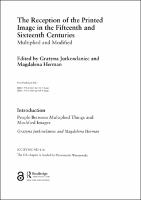Chapter Introduction People Between Multiplied Things and Modified Images
Proposal review
Author(s)
Jurkowlaniec, Grażyna
Herman, Magdalena
Language
EnglishAbstract
Printed images were, on one hand, material objects produced, owned or variously transformed by humans, but on the other hand, they were immaterial representations, conceived and variously received by humans as well. Certainly, such a complex relationship among things, people and images is not an exclusive feature of the premodern periods print cultures. However, the rise of printmaking challenged some established rules in the arts and visual realms. Three short insights may exemplify this rise of printmaking. The first insight s point of departure comprises material objects related to Lucas Cranach the Elders early Crucifixion; the second insight offers a human perspective, starting with Christophe Plantins working practices; and the third insight is a short story that emphasises the ambiguities surrounding what printed images represent, as epitomised by early modern depictions of wisent, a species related to the North American bison, but often confused with the Eastern European aurochs.
Keywords
art history; Renaissance; printed images; visual culture; European art historyISBN
9780367539405, 9781003029199Publisher
Taylor & FrancisPublisher website
https://taylorandfrancis.com/Publication date and place
2020Grantor
Imprint
RoutledgeClassification
History of art


 Download
Download